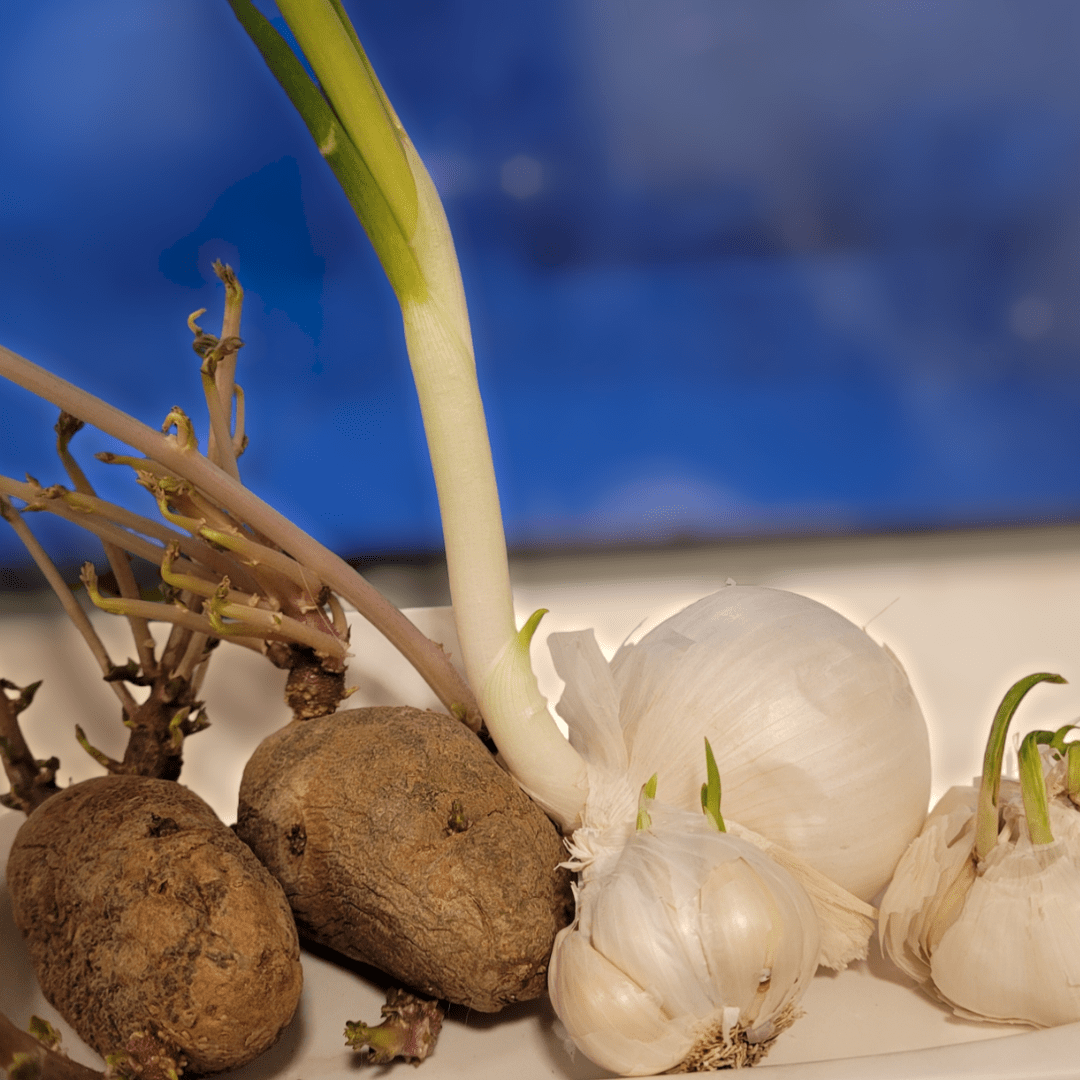Want to save money and reduce food waste? Learn how to regrow your grocery list by turning everyday kitchen scraps into a continuous supply of fresh, free food. From green onions and celery to lettuce, potatoes, and even herbs, this simple guide shows you how to regrow common groceries right at home—no garden required! Perfect for beginners, urban homesteaders, or anyone craving more food independence and less waste!
With little ingenuity and creativity, you can grow a cheap vegetable garden for free from the groceries you already buy. In this post, I aim to teach you how to grow your grocery list for free without buying a single vegetable seed. The more you know, the more you grow!
This is a pinnable post. Tap or hover over any image in this post to pin to your Pinterest Boards.
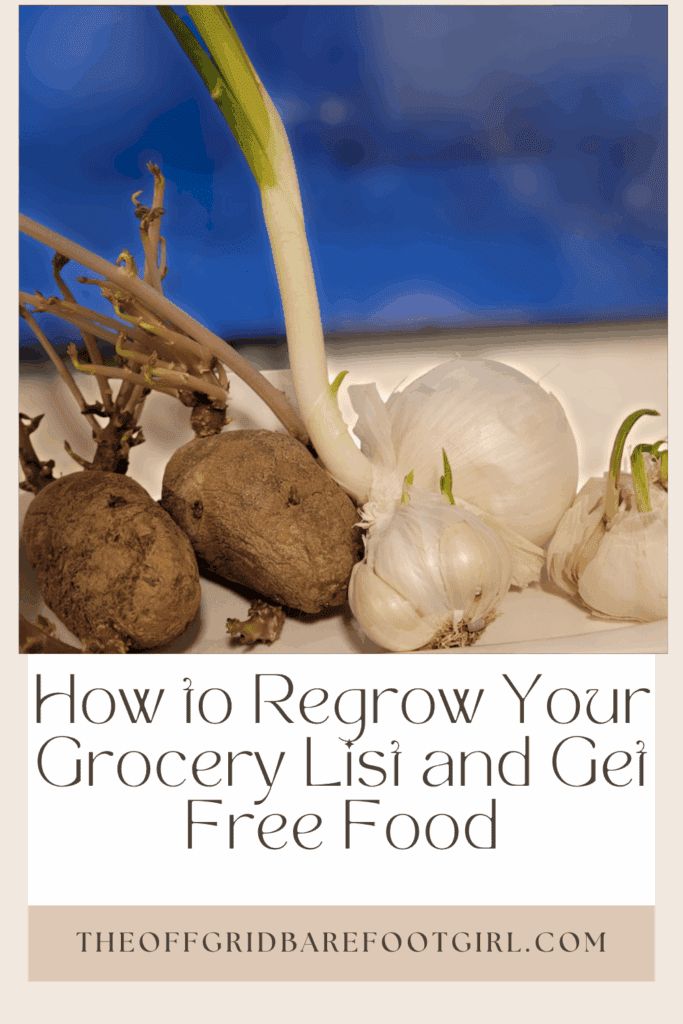
Buy Organic to Regrow Your Grocery List
It is best to buy organic when you can, since regrowing organic vegetables has a higher success rate. Therefore, it is important to pick healthy organic vegetables to regrow your food.
Organic foods regrow best since they have not been chemically treated to prevent new growth and sprouting, which is ideal for regrowing a new vegetable.
How to Regrow Your Grocery List
Knowing how to regrow the vegetables you have chosen to regrow is key to success in the garden. I will share my tips and tricks that can help you regrow the vegetables that I have regrown successfully out in my garden over and over again without buying a single seed. I am quite sure these are the basic vegetables that are regularly on your own grocery list.
The vegetables I have chosen for this project are vegetables that are easy to regrow for a continuous harvest and are considered survival foods, and are shelf stable for your pantry.
Let’s go over the best vegetables to regrow your grocery list.
Best Vegetables to Regrow Your Grocery List
Potatoes
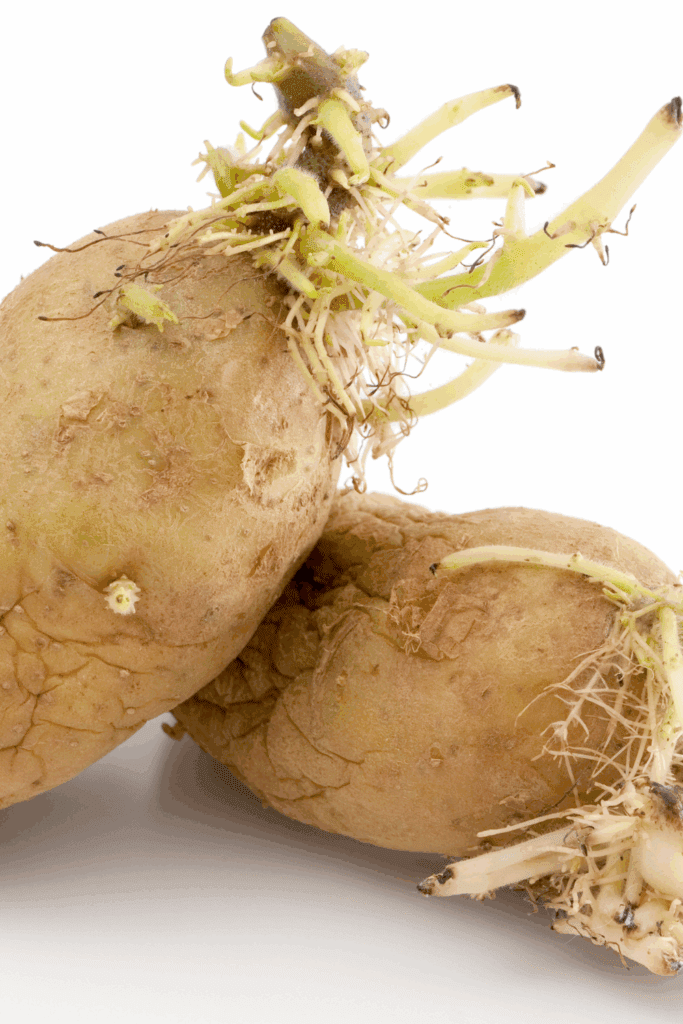
Regrowing organic potatoes is one of my favorite low-effort ways to get free food from what I already have on hand. If you’ve got a sprouting potato in your pantry, don’t toss it—plant it! I simply cut the potato into chunks, making sure each piece has at least one good “eye” (those little sprouting spots), then let them dry out for a day to prevent rotting.
From there, I plant them about 4 inches deep in a garden bed or a bucket filled with loose, well-draining soil (perfect for decks and patios!) As the plants grow, I keep adding soil or straw to “hill them up” and encourage more tuber growth. A few months later, I’m digging into a harvest of homegrown, organic potatoes—no trip to the store needed!
Sweet Potatoes
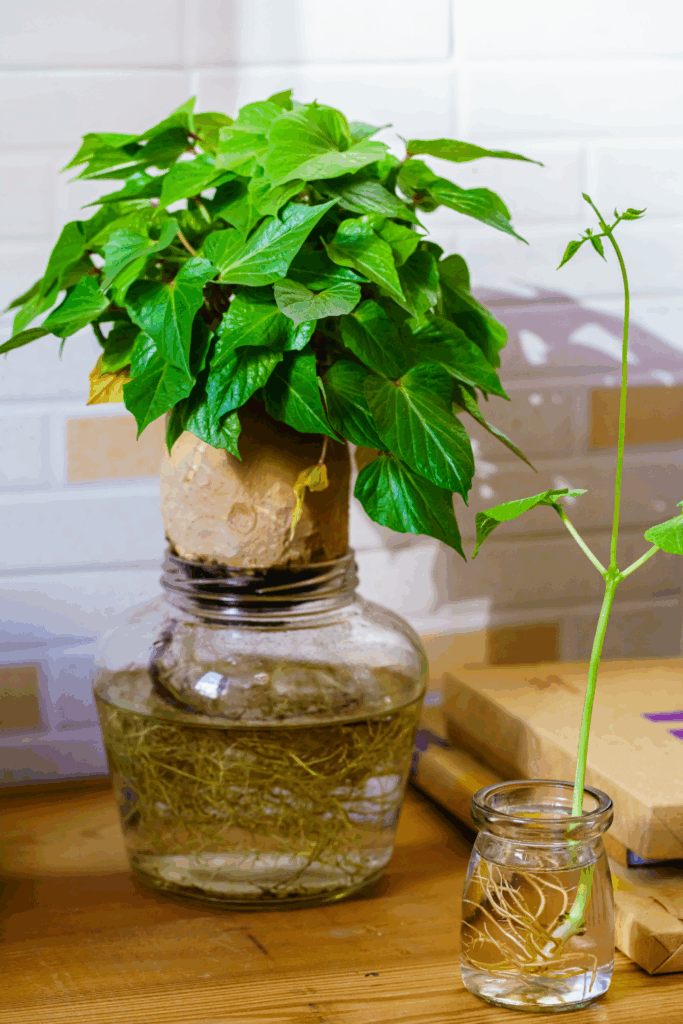
Growing sweet potato slips is a fun and rewarding way to turn one organic sweet potato into dozens of new plants. I start by placing a healthy, unpeeled sweet potato in a jar of water—either suspending it with toothpicks or laying it flat in a shallow dish—making sure half is submerged. I set it in a sunny window, and within a couple of weeks, leafy shoots called “slips” began to sprout.
Once they’re about 4–6 inches long, I gently twist them off and place each slip in its own jar of water to grow roots. After they’ve developed a strong root system, I transplant them into the garden or a large container. It’s amazing how one sweet potato can multiply into a whole patch of free, homegrown food!
Garlic (one head grows 10 to 12 garlic plants)
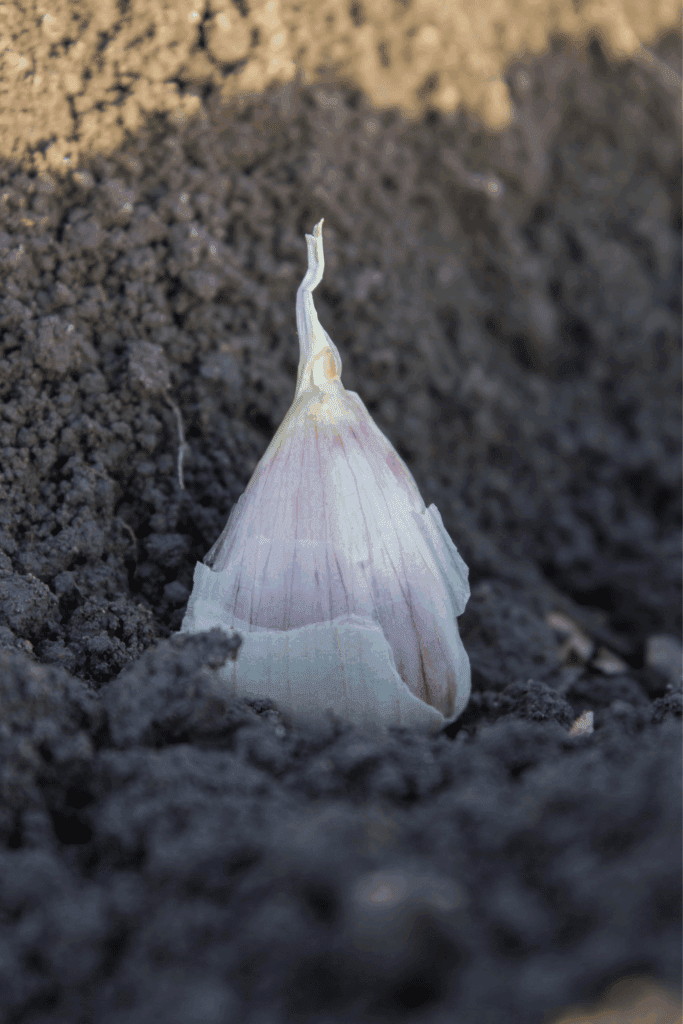
Garlic is probably the easiest crop I have ever grown! I grow a year’s worth of garlic (a massive harvest) each year without buying a single garlic seed. One head of garlic can produce 10 to 12 garlic plants, which to me is amazing! And I started my wonderful garlic garden by buying garlic from the grocery store!
Typically, I try to keep at least 500 garlic cloves in my fall garden bed each year, which produces a year’s worth of garlic for my family. To do this, all I need to do is plant about 50 heads of garlic from what I save from each harvest or the grocery store. You will need to do some math to configure how much garlic your family needs to plant that amount per year.
If you buy garlic, buy extra to plant during the fall season. Once you buy your garlic, you can save some for planting that following fall season to achieve a nice sizeable garlic harvest the following summer. I now never have to buy garlic from the store again!
Growing Garlic Bulbils
Garlic can be grown as a perennial. I love growing a regularly massive garlic bed to harvest in the summer, however, I also love growing garlic plants around my small cottage homestead in the form of garlic bulbils.
Garlic bulbils are tiny garlic seeds that can be planted into the soil in spring in areas where you want the garlic to produce consistently. Growing garlic from bulbils helps me keep garlic plants around my cottage homestead in areas where I can harvest garlic whenever I want.
Also, planting the garlic bulbils around the perimeter of my cottage brick home and around the fruit trees, help me fight against annoying garden pests that cause harm to my fruit trees and prevent bugs from coming into my home from the strong garlic perimeter presence planted around my home.
I talk more about growing garlic in my backyard orchard in this post!
Surprising Benefits of Growing Garlic Around Your Fruit Trees
Growing garlic bulbils requires a two-year growing season. Plant garlic in areas that you plan to not harvest in short term and allow garlic to grow in its perennial nature to produce garlic bulbil seeds that you can harvest in the spring.
Growing garlic as perennials in certain areas of your garden can help massively produce your free garlic production for a massive harvest each year and you will never have to buy garlic ever again! Plant garlic cloves or bulbils in an area you plan to designate permanently for your garlic harvest. Plan for at least two growing seasons for your garlic to begin to produce free garlic on its own for you.
Growing Garlic as Perennials
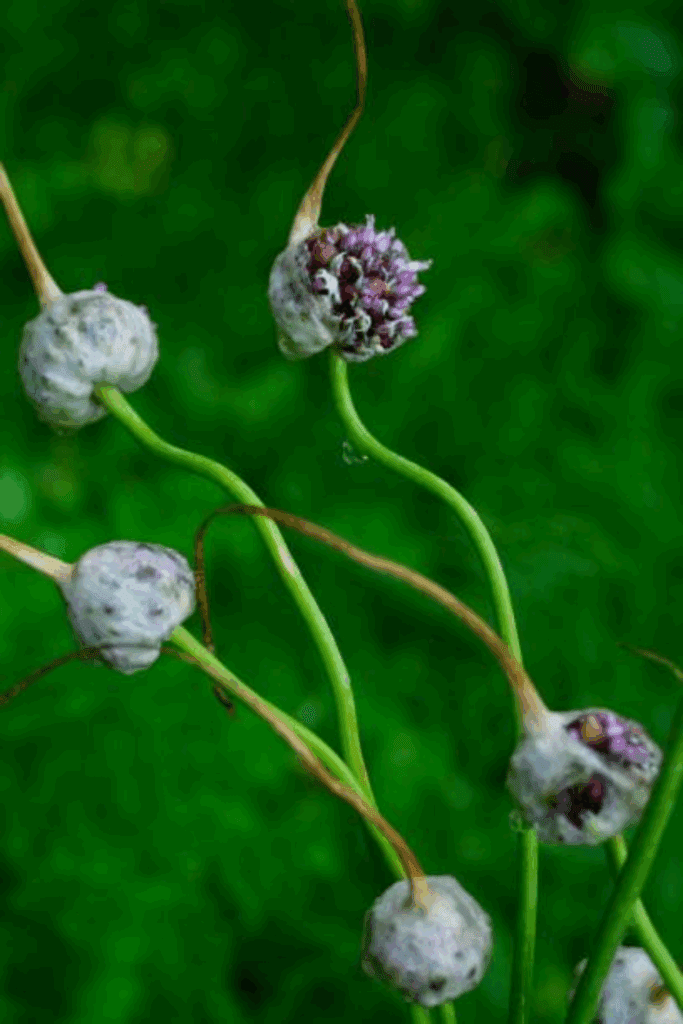
When you set aside garlic plants to allow them to go to seed, you will soon have yourself a perennial garlic garden. Garlic produces seeds called garlic bulbils, which drop into the ground to reseed themselves for a continuous garlic harvest that you get to reap and enjoy. This effort is far worth your time to produce free garlic for your cooking needs and you will never need to add garlic to your grocery list ever again.
Onions
Have your onions sprouted some green shoots? If not, allow a few of your onions to shoot up some greenery to plant in your spring garden. A few weeks before spring, allow some of your onions to sprout. Mine naturally do this in my pantry! Then follow these simple steps to regrow more onions from your store-bought onions and never put onions back on your grocery list ever again!
Most onions when they sprout will shoot up three individual green sprouts. To divide the sprouts, carefully begin to take the onion apart without disrupting the onion root sprouts. Cut the green sprouts from the onion and divide them into three parts according to how their roots can divide, keeping their roots intact.
The best way to do this is by carefully peeling each layer down to the center sprouts in the middle, ensuring you do not cut off the end roots. So be sure not to start cutting your onion as you normally would.
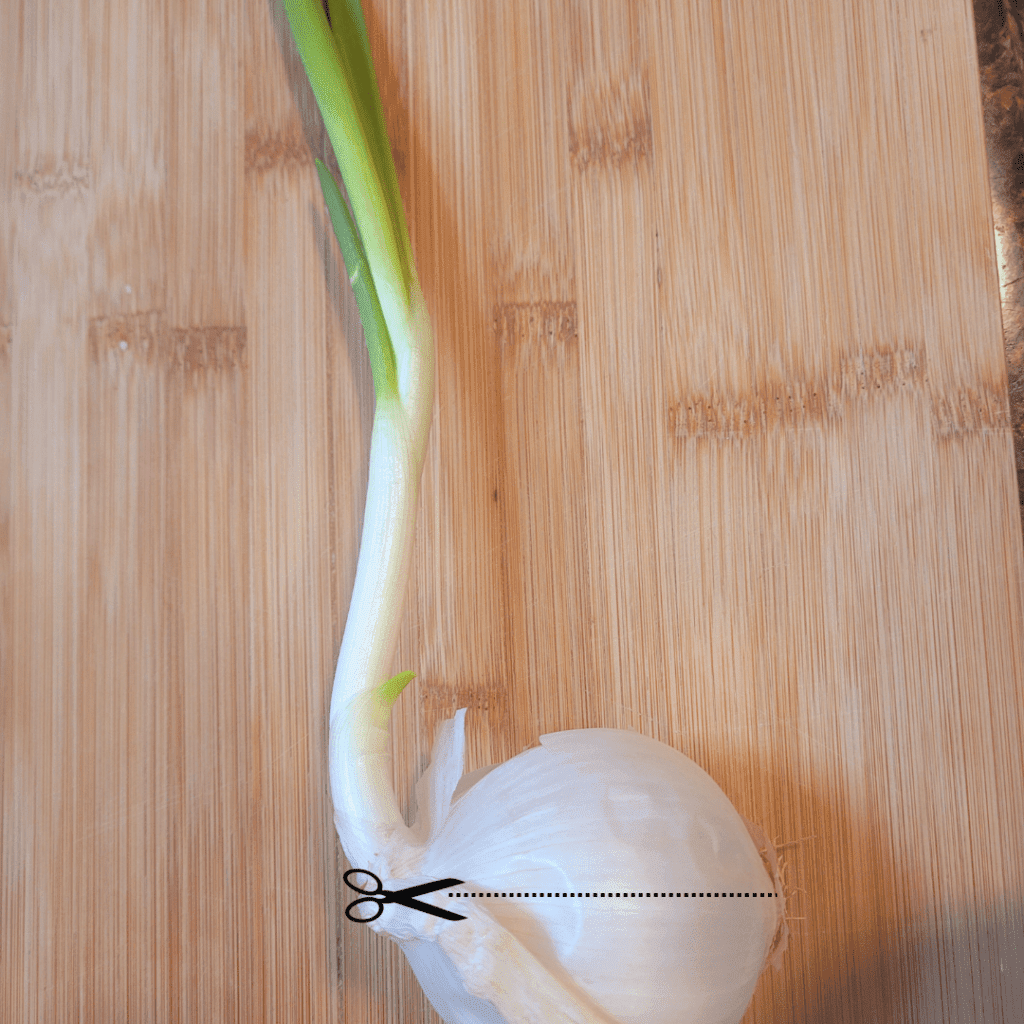
You can dice up the onion and use it in your dinner recipe on the day of separating your onion shoots.
Once you separate your onion shoots, plant them in separate containers if your garden is not ready. Otherwise, go ahead and plant them directly into your garden.
When I regrow a sprouted onion, I usually get green onion-like tops at first, which are perfect for snipping and using fresh in recipes. If I plant the whole sprouted bulb in soil, root end down, and just the tip peeking out, it continues to grow.
Over time, the bulb may split and form ne,w smaller onions, especially if it’s a variety suited for your growing season and climate. While it may not form a full-size onion again (especially in a container or short season), I often end up with a few small bulbs or lots of edible greens. Either way, it’s free food from something I might’ve thrown away—and that’s a win in my book!
Dried Beans
Dried beans are so simple to save and grow. When you buy your beans of any type, save several of them for planting in your spring garden. They will sprout and grow wonderfully producing fresh new beans for you to harvest. My favorite and consistent beans that I regrow are green beans, black beans, black-eyed Susans, and pinto beans. These are the types of beans that I use often in my home-cooked meals, so plan for what type of beans your family uses most and grow from there.
Keep your dried beans in a separate container for planting and for the amount you plan to plant for that year. You are now basically regrowing your grocery list!
Conclusion
Regrowing your grocery list is one of the easiest (and most satisfying) ways to save money, reduce waste, and build self-sufficiency right at home. Whether you’re sprouting green onions in a jar, rooting sweet potato slips on your windowsill, or planting potatoes in a bucket, you’re taking real steps toward food freedom. I’ve found that once you start regrowing just one item, it quickly becomes a habit, and soon, your kitchen scraps become a mini garden full of possibility. Start small, stay curious, and enjoy the harvest!
Resources: Here are some helpful resources for further information.
- How to Regrow Vegetable Scraps – By Simple Bites
- How to Regrow Vegetables from Food Scraps – By Thoughtfully Sustainable
- Don’t Toss it, Plant It! – By Farmer’s Almanac
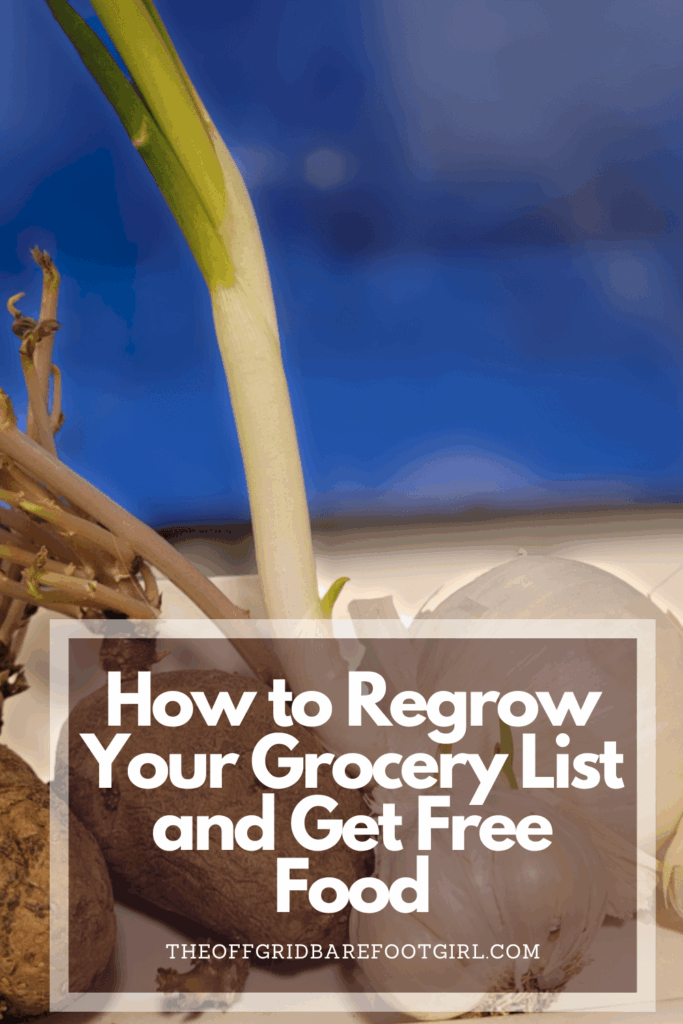
Frequently Asked Questions
1. Can I regrow food without a garden?
Yes! Many foods like green onions, lettuce, basil, and celery regrow beautifully in jars or small containers indoors—no backyard needed.
2. Do I need organic produce to regrow food?
Organic is ideal because non-organic produce may be treated with growth inhibitors. That said, some conventionally grown veggies still sprout—give it a try!
3. How long does it take to regrow vegetables?
It varies. Green onions regrow in about a week, while potatoes and sweet potatoes take a few months. Start with fast growers to build momentum!
4. Will regrown food be as nutritious as store-bought?
Often even better! When you regrow at home, you control the soil, water, and care, so your food is fresh, chemical-free, and harvested at its peak.
Summary
I hope I have inspired you to plant your garden with these tips and products.
If you were encouraged by this post, I invite you to check out my FREE Printables Page for fun free printables, planners, and charts.
ENTER MY FREE Printables Page HERE
Here are some more of my gardening inspiration posts to check out!
Spring Garden Soil Prep: How to Improve Your Soil
Seed Starting Mix 101: Everything You Need to Know!
How to Plan a 200 Sq. Ft. Vegetable Garden Layout
How I Easily Start My Seeds Without Expensive Grow Lights!
How to Create a Smart Garden: Tech Meets Nature!
The Best Cheap Raised Vegetable Garden Beds
How to Grow Artichokes: Plant Once and Harvest for 5 Years!
The Best 8 Fast-Growing Vegetables In Just 45 Days!
From Snow to Sow: Plan Your Spring Garden Now!
11 Fun Ways to Brighten Your Spring Garden with Personality
Top 10 Spring Garden Crops to Harvest in 30 Days and Eat Now!
The Best Survival Crops for Caloric Survival
My Victory Garden: What I Learned from 5+ Years
Why Every Family Should Have a Victory Garden in Their Backyard Now!
The Best Perennials for a Long-Term Survival Garden
The Best Essential Oils for Plants That Repel Garden Bugs
More Gardening Projects!
How to Grow Green Garden Peas: Perfect Plump Peas!
Hugelkultur: Does This Epic Pioneering Method Actually Work?
9 Ways to Celebrate Earthing Day in Your Garden!
Gardening Indoors: Secrets of Growing Your Food Inside!
How to DIY a Milk Jug Drip Irrigation System!
Why Cedar Mulch Is The Perfect Natural Weed Barrier
Gardening Projects
Onions: How to Grow Onions for Storage
Peas: How to Grow Garden Peas for a Bumper Crop
Carrots: How to Grow Carrots for a Bountiful Harvest
Prep Your Garden for Spring Planting with These Expert Tips!
How to Grow a Prepper Garden to Survive and Thrive
The Best Garden Tools You Need for a Productive Season
Fastest Growing Vegetables for Your Survival Garden
How to Grow Marigolds As Pest Control In Your Vegetable Garden
Must-Have Tools for a Successful Balcony Vegetable Garden
How to Effectively Combat Powdery Mildew in Your Garden
The Best Tips for Organic Gardening
How to Release Ladybugs In Your Garden for Organic Pest Control
The Best Garden Snail Control Strategies
The Best Spring Vegetables to Grow in Your Garden
Seed Starter Mix: How To Make Your Organic Seed Starter Mix At Home
How to Grow a Productive Canning Garden
How to Plant and Grow a Salsa Garden
Easiest Heirloom Vegetable Seeds to Grow Now
How to Use the Hand Twist Claw Tiller: Tackling Tough Soil
More Fun Gardening Posts to Check Out!
Planning Your Garden: How to Plan a Vegetable Garden: Expert Green Thumb Tips!
Winterizing the Garden: How to Winterize Your Vegetable Garden: Step-by-Step Checklist
Mulching the Garden: How to Make Leaf Litter Mulch
Grow a Pumpkin Patch: How to Grow a Pumpkin Patch in Your Backyard
How to Grow a Fall Garden: 9 Best Fall Crops
Clever Ways to Incorporate Indoor Composting into Your Home
How to Start Composting for the Garden: A Step-by-Step Guide
The Ultimate Guide to Composting in Your Suburban Backyard
Why I Built A Survival Garden in My Backyard
16 Best Medicinal Herbs to Grow in Your Garden Now
Blessings,
The Off Grid Barefoot Girl

